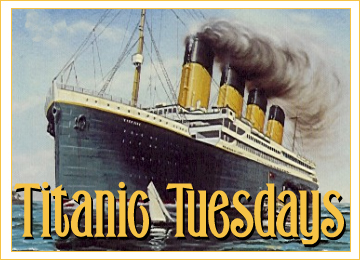
The Titanic has always been a subject of interest for people, even before the movie in 1997 brought it back to the forefront of public attention. And now, with the 100th anniversary of the disaster approaching, I imagine it’s going to be popping up everywhere again. Books, movies, documentaries, you name it. I’m excited, because I can never get enough Titanic (though I doubt I will be seeing the 3D re-release of the film, despite it being my favorite movie. 3D gives me a headache, and it’s been my experience that movies converted into 3D after the fact aren’t very effective. I prefer to watch it in its original format. I don’t need the iceberg coming out of my screen at me, or Rose’s hand reaching out towards me during the cargo hold scene – and you know they won’t be able to resist doing that.).
But with all the renewed interest and publicity, many long-standing myths and legends are bound to pop up again. “Facts” that get told over and over despite being untrue, passed along because people hear it often enough, they assume it’s reality. After all, we no longer have any first-hand witnesses living to set us straight, and even if we did, not all of them were always 100% reliable. Eyewitness testimony is hardly infallible, after all. Some people insisted to their dying day that the ship went down intact, and we know that’s not the case now that the wreck has been found. Others have conflicting stories about gunshots, officer suicides, where Captain Smith was, and how/if the third class was trapped belowdecks. For most of these, we’ll never really know the truth, because unlike Apolline in Destined (shameless self-promotion shout-out!), we can’t go back and see it for ourselves.
There are, however, many facts about the ship we do know, and myths that have been busted, yet still linger on. So I thought I’d take the opportunity in today’s Titanic Tuesdays post to point some of them out.
- There was not a mummy in the cargo hold. I’m not sure where that myth started, but it pops up now and then, even today. Researchers have never found proof that such a thing existed on the ship. Some believe the story came about because one of the passengers, William T. Stead, told his dinner companions about the mummy, which was on display in London at the time, and after the disaster, memories became jumbled and his story about the mummy turned into a story that it was on board the ship (and due to a curse, the cause of the disaster).
- The Titanic was not the first ship to use S.O.S. as a distress call. While it is true that S.O.S. was relatively new at the time (up until then, the standard distress call was C.Q.D.), the signal was used first by Germans in 1905, then adopted as a the new worldwide standard in 1908. It took time to catch on, which is why most ships took a while to switch over from the CQD they were used to.
- The officers (or White Star Line) were not trying to make a speed record on Titanic’s maiden voyage. Her maximum speed, with all boilers lit, was only 21 knots, and there were already faster ships out there. However, all of her boilers were never lit, and she was following a longer, more southerly route in order to (irony alert) avoid icebergs. Also, if they had tried to get into port on Tuesday night, rather than Wednesday, as many rumors stated, it would have been a huge inconvenience to everyone on board. Just imagine the uproar from the elite in First Class at being brought to shore the night before they had made arrangements to be picked up or transferred to trains (not to mention all the hotel reservations starting on Wednesday)!
- J. Bruce Ismay, managing director of the White Star Line, was not quite the villain many believe. His biggest crime was surviving. He did not sneak onto a boat to save himself. He helped load the boats along with the other officers, and according to witnesses, entered a half-filled boat as it was being lowered only after being ordered to. It makes you think, really: many other men survived without being vilified for it, and many who perished tried to get on boats with little regard to the others around them. It’s a shame that Ismay had to live out the rest of his life under such a cloud when he did not really do anything wrong by getting on that boat. If it truly was already being lowered, the seat he took would have remained empty had he not boarded. If he had stayed on the ship, he would have died, but no one else would have survived in his place. Sadly, if he had stayed on board, he would probably be considered a hero today, right up there with Captain Smith and Thomas Andrews.
- Another common story about Ismay is that he was pressuring Captain Smith to go faster (again, the speed record myth). We’ll never know for sure if this was true, though some passengers claimed to have overheard him talking to the Captain about picking up speed. Still, Smith was too experienced a sailor to take direction from a businessman like Ismay. He would not have altered his course or speed just to please him.
- The Titanic was not felled by a 300-foot-long gash in her hull. While the damaged portion of the hull is still buried in sand, it has been determined that such a large gash is not likely. Instead, scientists say that the sinking was caused by the steel plates buckling under the force of the iceberg as it scraped along the side of the ship, popping off rivets as it went. Some believe the quality of the steel used in making the rivets was sub-par, and therefore caused them to fail. As the rivets popped off, seams were opened and water rushed in.
- No one ever claimed the Titanic was unsinkable. While the ship was described as “practically unsinkable” by Shipbuilder magazine, no one ever declared it as such. It was true that she was built so that she would be very difficult to sink, but as fate would have it, the iceberg struck in just the right way to remind everyone that something that large and heavy can, in fact, sink. Had Titanic hit the berg head-on, it is very possible she would have limped away damaged, but still seaworthy. The watertight compartments were designed so that the ship would stay afloat if any two were filled, and even if the four forward compartments were filled. Unfortunately, sideswiping the berg meant six compartments filled, sending more water into the ship than she could handle. And as anyone who has seen the movie knows, the bulkheads separating the watertight compartments only reached up to E Deck. Once the ship started going down at the bow, water flowed over the tops of the bulkheads and began filling more compartments. The compartment in the front of the ship, however, reached higher, and therefore might have kept water from flowing back into the ship had it been the only section of the hull compromised.
I was going to continue this with film-specific inaccuracies, but rather than get too long, I’ll leave that for another week.










I find it fascinating! I read a rumour recently that there were no cats on board which is bad luck (which is why the ship sank) Also that people saw a cat and her kittens leaving the ship just before it set sail..again very bad luck! ;)
ReplyDeleteThank you. :) I have also read that a crewman who came to Southampton on the ship (when she left Belfast after being built) saw a cat take her kittens off at that point and considered it bad luck. I haven't read anything about cats on board during the maiden voyage, though. I know it was common to have cats on a ship to keep the mice in check, but since Titanic was brand new, mice might not have been a problem yet.
ReplyDelete